#sacred trees
Text


Polash/Sacred Tree
80 notes
·
View notes
Photo

Legends and myths about trees
Shinboku (lit. tree of God) – Sacred trees where gods dwell in Japanese prehistoric Shintoism
A sacred tree (shinboku) is a tree or forest worshipped as a shintai - a physical object of worship at or near a Shinto shrine, worshipped as a repository in which spirits and deities reside, or where they descend. They are often distinctly visible due to the shimenawa (lit. 'enclosing rope') wrapped around them. Types of sacred trees include evergreen cedar, pine and cleyera japonica (sakaki) that is regarded as a representative sacred tree and is often used in Shinto rituals.
In ancient Shinto, the Himorogi (lit. "divine fence") was considered to be a place where the gods dwelled, or a boundary between the everlasting world and the present world, and was feared and respected. In order to prevent people, things in this world, gods in this world, and things that bring misfortune and evil to this world from easily coming and going, shimenawa were hung as walls, making it a forbidden place.
Generally, the term refers to trees that are regarded as divine or sacred, as well as the guardian forests that surround them and that are not supposed to be cut down.

木にまつわる伝説・神話
神木 (しんぼく) 〜 日本の古神道における神の宿る樹木
神木 (しんぼく)とは、神社や祭壇の近くに祀られて���る木や森のことで、霊や神さまが宿る場所、神さまが降臨する所とされていた。注連縄が巻かれているため、はっきりと見えることが多い。神木の種類としては、常緑樹の杉や松、榊 (さかき) などがある。 この中でも榊は代表的な神木とされ、神事にも多く使われている。
古神道において神籬 (ひもろぎ) は、神の宿る場所としての神域、または常世 (とこよ) と現世 (うつしよ) の境界考えられ、恐れ敬った。また、現世の人々やもの、常世に存在する神々や現世に災いや不幸をもたらすものが、容易に出入りできないように、結界として注連縄をはり、禁足地とした。
一般的に、神体としての木や神聖視される木、その周りを囲む鎮守の森や、伐採をしないとされる木を指す。
#trees#tree legend#tree myth#legend#mythology#shintoism#shinboku#sacred trees#tree of god#philosophy#nature#art
151 notes
·
View notes
Text
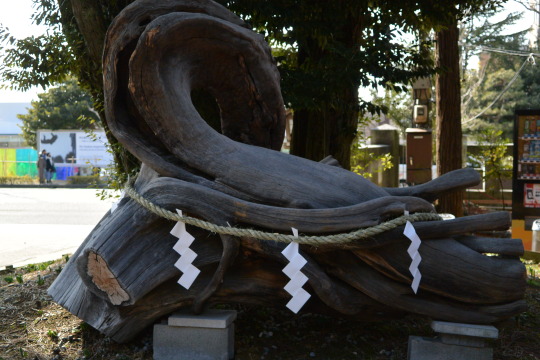
金沢・石浦神社の御神木
21世紀美術館の前に観光客の方もご存じの、金沢最古の神社・石浦神社がございます。
創建は今から約2200年前です。
(まじか!京都でもここまで古い神社はめったにないよ)
去年、新しく御神木が来たというので関係者の方から連絡が来て、「SNSで紹介してくれ」と言われていたことをすっかり忘れていまして、今紹介します。
(遅いよ。笑)
今は表示板?とかが置かれていますが、写真は設置されてすぐなので、しめ縄だけの貴重な写真です。
ある会社の社長が見た瞬間何かしらビビっときてクレーンで拾ってきた木なのですが、それまでどん底だった会社が、この木を会社の前に供えてから会社が好転しだして大きくなってこれは霊験あらたかな御神木だということで、この歴史のある神社に奉納されたというわけです。
(日本昔ばなしか)
このエピソードは誰も知らないと思うので、今見ている人はラッキーです。
石浦神社に来た際は、この木を優しく撫でるとお金持ちになれるそうですのでタップリ撫でまわしてください。
(なぜ、いつも早々に君の所に神社仏閣から連絡が来るのか?笑)
24 notes
·
View notes
Text
Dryad.
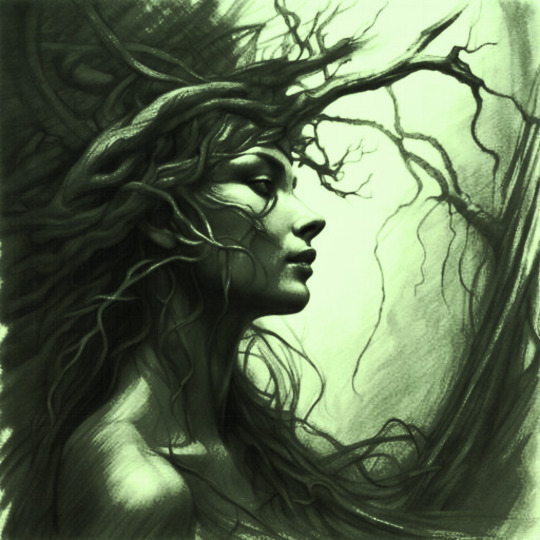
#ancient greek mythology#forest dryad#forest guardian#forest sprite#forest spirit#dark forest#dryad art#dryads#alteredai#hamadryads#hamadryas#nature spirits#nature worship#nature goddess#sacred trees#sacred grove
16 notes
·
View notes
Text



Over 100 year old Ficus tree, Bali Botanical Garden, Bedugul, Bali - Indonesia.
18 notes
·
View notes
Text

Growth rings of Bristlecone Pine. The oldest living things on earth. Please zoom in and reflect on how many winters these sacred trees lived through at over 10,000 ft. elevation.
14 notes
·
View notes
Text
I feel like someone is going to come for me for blasphemy over this one but I don't think pre-Christian Irish had sacred groves.
the idea of sacred groves mostly comes to us from classical writers who.... mostly couldn't tell the difference between Gaulish traditions and Germanic traditions after you get far enough North to run into tribes who weren't influenced by the Romans (see the theories that Celtic 'sacred mistletoe' was actually a Germanic tribal thing)
Gaulish and Germanic tribes had a lot of cultural sharing, so maybe they both did?
continental celtic traditions do not always translate to insular traditions and vice-versa
We see a reverence for trees of all varieties in Irish pagan tradition and we see sites, and mentions of sites, where there is A sacred tree (or 3 in the Irish mythological trope) but I'm unaware of mentions in antiquity or the mythology noting the use or existence of sacred groves
In fact, most mentioned religious activity happens in a field, at a well (which sometimes has A tree), or by a river/bog/other water (the water being the focus, not the land)
#irish#irish mythology#irish paganism#irish polytheism#irish reconstructionism#irish reconstructionist#sacred trees#sacred groves
9 notes
·
View notes
Text
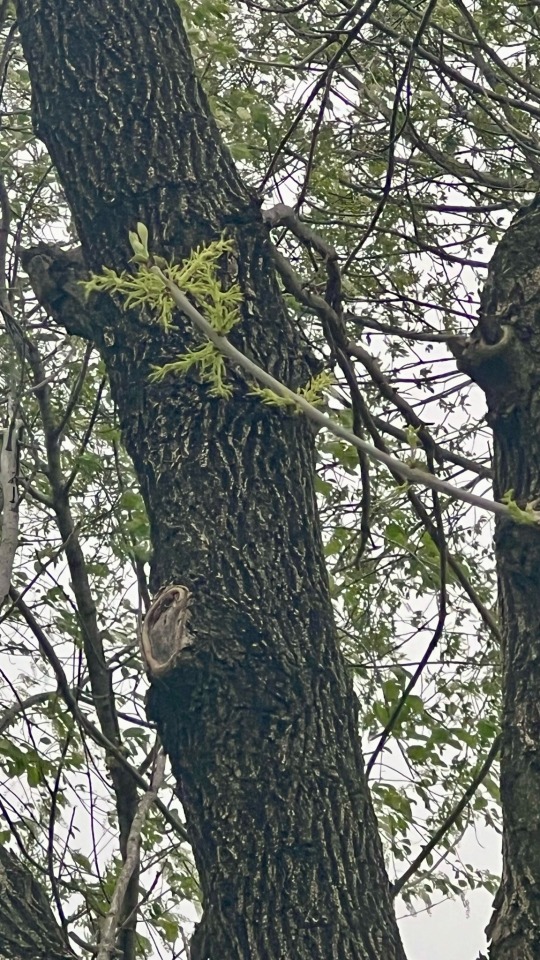
Ash Tree, Druid Sacred Tree
#ash tree#original photographer#photographer on tumblr#original photographers#photographers on tumblr#photography#photooftheday#photoblog#beautiful photos#trees#happy tree friends#druid#druidism#ash#colorful#green#color photography#nature#sacred trees
3 notes
·
View notes
Text
Thompson (1881), who traveled in Palestine in the 19th century, reported that the local in- habitants believed that spirits called "Jacob's Daughters" occupied many sacred trees. People were afraid of these trees and when they passed nearby they used to hang a piece of their own clothes on the tree as an acknowledgement of their presence, and a sort of peace offering to avert their anger. Some trees in Israel are known to be haunted by evil spirits and people are warned to avoid them, and especially not to sleep underneath
Amots Dafni, Why Are Rags Tied to the Sacred Trees of the Holy Land?, Economic Botany, Winter, 2002, Vol. 56, No. 4 (Winter, 2002), pp. 315-327
39 notes
·
View notes
Text
In years long gone, too many for the almanac to tell of, or for clocks and watches to measure, millions of good fairies came down from the sun and went into the earth. There, they changed themselves into roots and leaves, and became trees. There were many kinds of these, as they covered the earth, but the pine and birch, ash and oak, were the chief ones that made Holland. The fairies that lived in the trees bore the name of Moss Maidens, or Tree "Trintjes," which is the Dutch pet name for Kate, or Katharine.
The oak was the favorite tree, for people lived then on acorns, which they ate roasted, boiled or mashed, or made into meal, from which something like bread was kneaded and baked. With oak bark, men tanned hides and made leather, and, from its timber, boats and houses. Under its branches, near the trunk, people laid their sick, hoping for help from the gods. Beneath the oak boughs, also, warriors took oaths to be faithful to their lords, women made promises, or wives joined hand in hand around its girth, hoping to have beautiful children. Up among its leafy branches the new babies lay, before they were found in the cradle by the other children. To make a young child grow up to be strong and healthy, mothers drew them through a split sapling or young tree. Even more wonderful, as medicine for the country itself, the oak had power to heal. The new land sometimes suffered from disease called the val (or fall). When sick with the val, the ground sunk. Then people, houses, churches, barns and cattle all went down, out of sight, and were lost forever, in a flood of water.
But the oak, with its mighty roots, held the soil firm. Stories of dead cities, that had tumbled beneath the waves, and of the famous Forest of Reeds, covering a hundred villages, which disappeared in one night, were known only too well.
Under the birch tree, lovers met to plight their vows, and on its smooth bark was often cut the figure of two hearts joined in one. In summer, the forest furnished shade, and in winter warmth from the fire. In the spring time, the new leaves were a wonder, and in autumn the pigs grew fat on the mast, or the acorns, that had dropped on the ground.
So, for thousands of years, when men made their home in the forest, and wanted nothing else, the trees were sacred.
-From The Legend of the Wooden Shoe (as appears in Dutch Fairy Tales for Young Folks)
#fairy tale#dutch fairy tale#trees#oak trees#sacred trees#animism#posting this partially to spite james cameron and his racist ass#and also because it's genuinely cool
4 notes
·
View notes
Photo
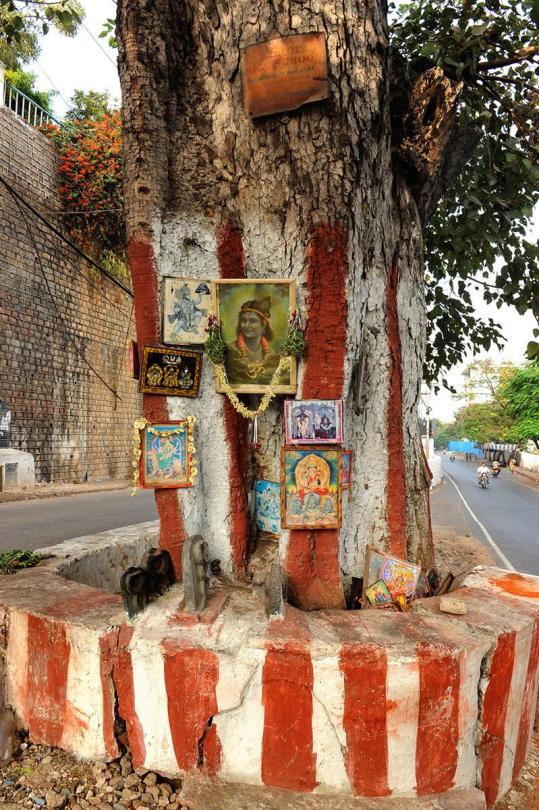
Deidi von Schaewen, from the series Sacred Trees of India
7 notes
·
View notes
Photo

Legends and myths about trees
Trees in Buddhism (3)
Sal tree (Shorea robusta) – the Nirvana
In Buddhism, there is an important day called 'Sanbutsuki (3 anniversaries of the Buddha)', which commemorates three major milestones in the Buddha's life.
These are Buddhist rituals of the Nativity on 8 April, when Buddha was born, the Jodo-e (becoming a Buddha) on 8 December, when he attained enlightenment, and the Nirvana on 15 February, when he passed away.
The Buddha's death is believed to have occurred on 15 February of the lunisolar calendar in China and Japan, and in many places it is now held on 15 March.
According to Buddhist tradition, the Buddha was lying between a pair of sal trees when he died:
Then the Blessed One with a large community of monks went to the far shore of the Hiraññavati River and headed for Upavattana, the Mallans' sal-grove near Kusinara. On arrival, he said to Ananda (Ref1), the chosen disciple, "Ananda, please prepare a bed for me between the twin sal-trees, with its head to the north. I am tired, and will lie down. (DN16; Nirvana Sutra)"
When the Buddha died in Kusinara, there were 4 or 8 sal trees on the 4 corners of his bed. They were said to have bloomed at the same time, then quickly withered and turned white, just like a flock of cranes.
In Buddhism, the brief flowering of the sal tree is used as a symbol of impermanence and the rapid passing of glory. The sal tree is also said to have been the tree under which Kondana and Vessabhu, respectively the fifth and twenty fourth Buddhas preceding Gautama Buddha, attained enlightenment.
The sal tree (shorea robusta, sāla, shala, sakhua, or sarai), is a species of tree in the family Dipterocarpaceae. The tree is native to India, Bangladesh, Nepal, Tibet and across the Himalayan regions.
The sal tree is mythologically classified as a 'tree of life', symbolising resurrection, rebirth and rejuvenation, but in Buddhism it is one of the three most sacred trees, symbolising parinirvana, as the Buddha died under two sal trees in a row.
The three most sacred Buddhist trees are:
Ashoka tree: the tree where the Buddha was born (Ref).
Bodhi tree: the tree where the Buddha attained enlightenment
Sal tree: the tree where the Buddha died.
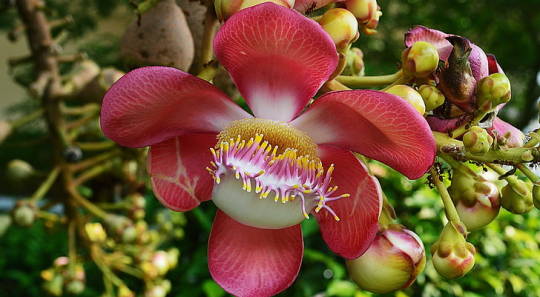
木にまつわる伝説・神話
仏教の樹木 (2)
沙羅双樹 (サラソウジュ) 〜涅槃会 (ねはんえ)
仏教には、ゴータマ・ブッダの生涯における3つの大きな節目を記念する「三仏忌 (さんぶつき)」という大切な日がある。
それが、ブッダが生まれた4月8日の降誕会 (こうたんえ)、悟りを開いた12月8日の成道会(じょうどうえ)、そして入滅した2月15日の「涅槃会(ねはんえ)」。
ブッダの入滅は中国や日本では旧暦2月15日とされ、現在は3月15日に行なわれているところが少なくない。
また、仏教の伝統によると、ブッダは入滅したとき、一対の沙羅双樹 (サラソウジュ) の間に横たわっていた。
その後、大勢の僧侶たちの中から選ばれたアーナンダ(参照1)はヒラニャーヴァティ川の向こう岸に行き、クシナラ近くのマッラ族の沙羅樹の林、ウパヴァッタナへ向かった。到着すると、ブッダはアーナンダに言った。「アーナンダ、2対の沙羅双樹 (サラソウジュ) の間に、頭を北に向けた寝床を用意してください。私は疲れているので、横になります。(DN16; 大般涅槃経)」
ブッダがクシナガラで死去したとき、臥床の四辺に4双8本の沙羅双樹 (サラソウジュ)があった。時じくの花を咲かせ、たちまちに枯れ、白色に変じ、さながら鶴の群れのごとくであったという。
仏教では、沙羅双樹 (サラソウジュ)の木の短い花は、無常と栄光の急速な通過の象徴として使用されることもある。また、沙羅双樹 (サラソウジュ) は、ゴータマ・ブッダに先立つ5番目の仏陀であるコーナニャーと24番目の仏陀であるヴェッサブーが悟りを開いた木であると言われている。
沙羅双樹 (サラソウジュ)はフタバガキ科の樹木の一種で、インド、バングラデシュ、ネパール、チベット、ヒマラヤ地方に自生している。
沙羅双樹 (サラソウジュ)は神話学的には復活・再生・若返りの象徴である「生命の木」に分類されるが、仏教では二本並んだ沙羅の木の下で釈尊が入滅したことから般涅槃の象徴とされ、仏教三大聖樹のひとつである:
無憂樹: 釈迦が生まれた所にあった樹木(参照)
印度菩提樹:釈迦が悟りを開いた所にあった樹木
娑羅双樹:釈迦が亡くなった所にあった樹木
#trees#tree legend#tree myth#trees in buddhism#sal tree#buddha#nirvana#ananda#buddhist rituals#philosophy#nature#art#sacred trees
167 notes
·
View notes
Text
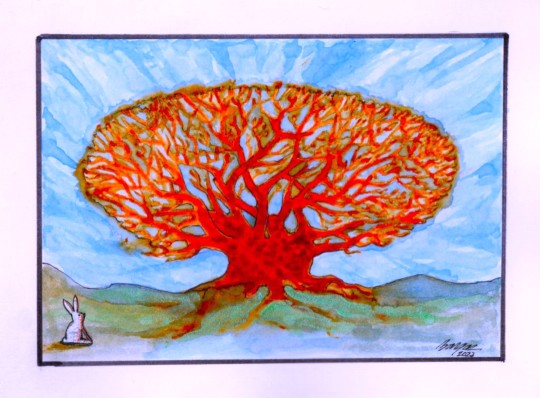
Sacred Bunny Tree
by Jim Bargas
1 note
·
View note
Text
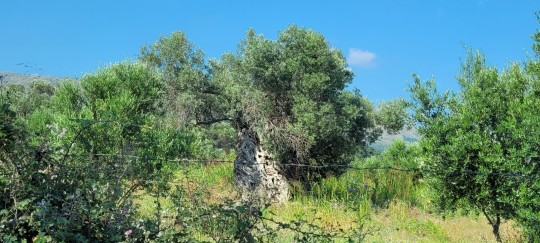
Our guide told us this olive tree is somewhere over 1500 years old, if I remember right
#olive tree#crete#greece#mind blowing how trees this age can still survive#imagine the people who have interacted with this tree#sacred trees#my photo
0 notes
Text

Every time I think about the Tree of Feelings I can't help but be a little underwhelmed at how the most popular depictions of it is just. the tree. on a hill. surrounded by miles of nothing but grass and maybe a few houses in the distance.
Yeah, no thanks. I'll just go with my own interpretation on this one
#dreamtale#utmv#undertale au#dryeart#my art#fanart#not that it's bad#but for a sacred tree that needs constant protection...#that damn tree can be spotted from miles away#with no natural barriers#like. come on.#something like a forest or valley would make so much more sense. hell even a mountain would work better#and idk maybe even have a magical forest surrounding and also acting as a barrier for the important magical tree#instead of just. relying solely on a couple of prepubescent children#dream sans#nightmare sans#they're the little silhouettes under the tree it fucking counts#digital art#digital painting#environment art#concept art
2K notes
·
View notes
Text
TREES ARE SACRED: A Case of Nakonde's Muzombo tree
TREES ARE SACRED: A Case of Nakonde’s Muzombo tree

View On WordPress
0 notes